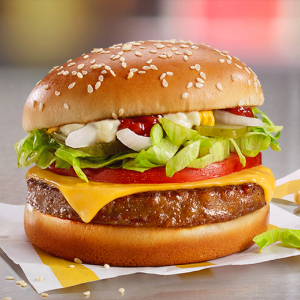À propos of yesterday’s update on the growing list of lawsuits being filed against Fast Food companies over alleged ‘false and misleading’, and outright ‘deceptive’ ads, we are delighted to expose a collection of hacks and sleight-of-hand moves ad makers use to suck us in…
and hacks advertising types use to suck us in…
‘More Human than Human!’
That was the slogan of Tyrell Corporation, developer of the Replicants in Blade Runner. And when those bio-androidic ‘people’ started to develop their own emotions – and discovered they had been given only a 4-year lifespan – things got crazy. Because they were faster, stronger, smarter and more resilient than plain old humans.
Well, Tyrell’s boast was no deception or overstatement. But the similar glamorizations used by food makers, processors, and restaurants these days often are. So claim the folks who’ve filed lawsuits against Burger King, McDonald’s and Wendy’s complaining that the Fast Food giants have been ‘overstating’ (see photo, top of page) and under-delivering on their burger ads. (See yesterday’s post.)
So I decided to do some recreational Googling…
… And found the video embedded above explaining how photographers and videographers cheat our senses when they make food ads. What shocked me most was the lengths they went to, to misrepresent products, and the industrial chemicals they used to create some of their fantasy images – which rendered the food totally inedible.
Creeping dishonesty
It’s a case of creeping corruption. The fashion magazines have been deceiving readers for decades, using every hair styling and makeup trick in the book, and manipulating the models and the clothes themselves to optimize the ‘look’. And that doesn’t even touch on the question of ‘photoshopping’ – which can literally place one person’s head on another’s body, and make an already-thin person positively stick-thin – if that’s what the couturier wants. Photoshopping has become universal in advertising. And, yes, they use it to enhance food ads, too.
So, the obvious question: Why is photoshopping legal, if it’s so blantantly deceptive? Because it started out as a relatively benign process, used to correct small imperfections in original photographs. But as the software’s capabilities improved and expanded, so did the skills of the operators – and the expectations of the clients. Creeping dishonesty. And it seems that society has decided, since ‘everybody knows’ every ad is manipulated, the playing field is level.
Similarly, everybody knows that the so-called ‘client’ testimonials in most video ads are really ‘actor portrayals’. That one was settled after legions of consumers complained that the testimony was unrealistic – deceptive. Now, most of us assume that the ‘clients’ in insurance, repair service and other ads are actors, and the words they’re speaking aren’t necessarily what the real client said (or wrote). In fact, some ads that do use real clients now make a point of saying something like, “Real clients – Not actors” in not-so-small print at the bottom of the screen.
Food is something else, again
At least in my humble opinion. But even though I know that the product I get at the Fast Food resto will not even come close to matching the masterpiece shown in the ads, I go along with the routine.
I know I’ve been part of a dance of deception in which the seller has done their utmost – at a huge investment of time and cash – to make their wares attractive, and the buyer knows the real world won’t be able to compete with the fantasy. It’s almost a tribal rite of contemporary western culture.
At their extremes, ‘enhanced’ advertising images can cross the line in to deception territory. And advertisers keep pushing the envelope. Hence the spate of lawsuits – claiming, essentially, that advertisers have gone too far.
On the other hand, the advertisers will insist that, since ‘everybody does it’, and ‘everybody knows it’, photoshopping and ‘staging’ their images to the hilt simply puts them on an equal footing with their competitors.
Too bad the customers have to learn to live with disappointment.
~ Maggie J.

